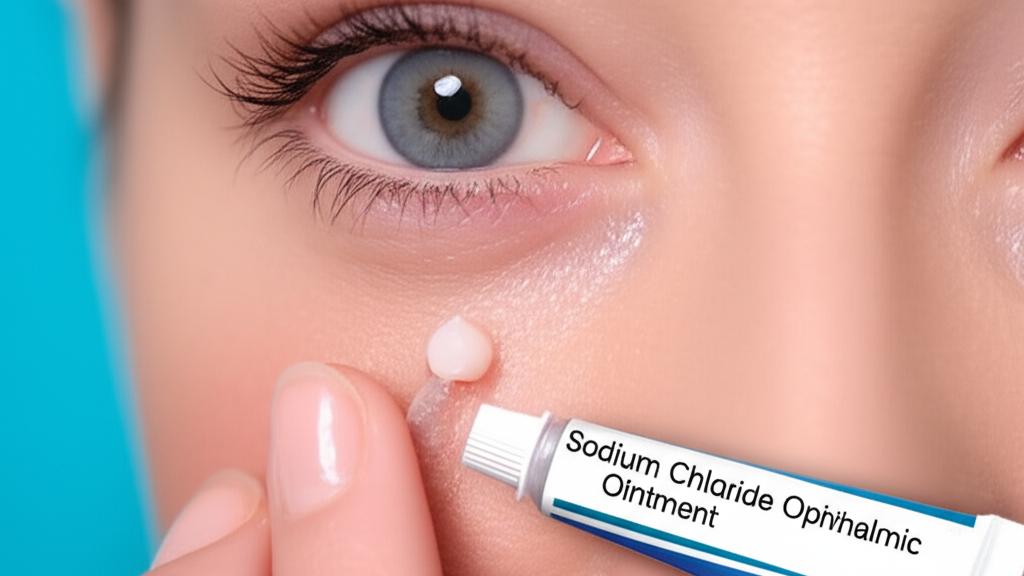Waking up to blurry or hazy vision can be really unsettling. It might feel like you’re looking at the world through a foggy window, and no amount of blinking seems to help. Often, this is caused by a little extra fluid that’s built up in the cornea, the clear front part of your eye. When we need to gently draw that fluid out and reduce the swelling, a treatment like Sodium Chloride ophthalmic ointment can be a huge help.
It sounds a bit clinical, I know. But it’s actually a very straightforward and effective tool we use. Let’s walk through what it is and how to use it, just like we would in the clinic.
What Is This Ointment, Exactly?
At its core, Sodium Chloride ophthalmic ointment (you might see brand names like Muro 128) is a sterile, hypertonic eye ointment. “Hypertonic” is just a fancy way of saying it’s a salt solution that’s more concentrated than your natural tears.
Think of it like this: the ointment is “saltier” than the fluid inside your cornea. Because of a natural process called osmosis, this higher salt concentration gently pulls the excess water out of your cornea. The result? The swelling goes down, and your vision gets clearer. It’s a simple bit of science that can bring a lot of relief.
Before You Start: A Quick Chat
Before you begin using any new medication, even an ointment, it’s important we’re on the same page. I’ll always want to know a few things to make sure this is the right and safe choice for you. Be sure to tell your doctor if you:
- Have noticed any recent changes in your vision.
- Have an active eye infection or have recently had an eye injury.
- Wear contact lenses.
- Are pregnant, planning to become pregnant, or breastfeeding.
- Have ever had an allergic reaction to sodium chloride, other medicines, or even preservatives in eye drops.
This information helps us make the best decision for your health.
How to Use the Ointment: A Step-by-Step Guide
Applying eye ointment can feel a little awkward at first, but you’ll get the hang of it quickly.
- Start with Clean Hands: Always wash your hands thoroughly with soap and water before and after you apply the ointment.
- Get Comfortable: Tilt your head back slightly. With your index finger, gently pull your lower eyelid down. This creates a small pocket or pouch for the ointment.
- Apply a Small Amount: Squeeze the tube to apply a thin line of ointment (about a quarter-inch) into that little pouch. Try your best not to let the tip of the tube touch your eye, your fingers, or any other surface. This keeps it sterile.
- Close and Spread: Let go of your eyelid and close your eye gently for a minute or two. This helps spread the ointment over the surface of your cornea.
It’s totally normal for your vision to be a bit blurry right after you put the ointment in. That’s just the ointment doing its job, and it will clear up.
Be sure to use the medicine exactly as prescribed, and don’t stop using it just because you feel better, unless we’ve discussed it first.
A quick note for contact lens wearers: You’ll need to take your lenses out before applying the ointment. Wait at least 15 minutes after using the ointment before you put them back in.
Potential Side Effects: What’s Normal and What’s Not
Most people tolerate this ointment very well, but it’s good to know what to look out for. I’ve broken down the side effects into two groups to make it simple.
| Call Your Doctor Right Away If You Experience: | Common Side Effects (Usually Not a Concern) |
|---|---|
| Any signs of an allergic reaction, like a skin rash, itching, hives, or swelling of your face, lips, or tongue. | A mild, temporary stinging or burning feeling right after you put the ointment in. |
| Any new or worsening eye pain. | Temporary blurred vision immediately after application. |
| A change in your vision that doesn’t go away. | |
| Eye redness or irritation that gets worse or lasts for more than 3 days (72 hours). |
If something feels off or worries you, please don’t hesitate to call the clinic. That’s what we’re here for.
Take-Home Message
- Purpose: Sodium Chloride ophthalmic ointment is used to reduce swelling (edema) in the cornea by drawing out excess fluid.
- Application: Wash your hands, create a pouch with your lower eyelid, apply a small amount without touching the tip to any surface, and gently close your eye.
- Contacts: Remove contact lenses before use and wait at least 15 minutes before reinserting them.
- When to Call Us: Contact your doctor if you have signs of an allergic reaction, new eye pain, vision changes, or irritation that worsens or lasts more than 72 hours.
- Normal Effects: Temporary stinging and blurry vision right after application are common and should pass quickly.
Dealing with any kind of eye issue can be stressful, but you’re not going through it alone. We’ll work together to get your eyes feeling better and your vision back to being crystal clear.


